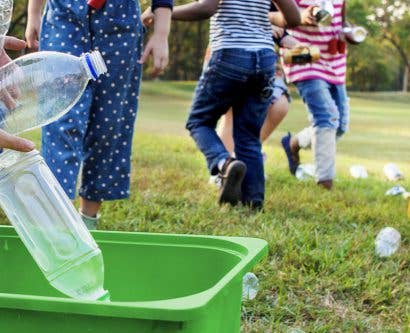10 Ways to Reduce Food Waste at School
Food waste has an immensely detrimental effect on the planet and is one of the largest contributors to greenhouse gas emissions. In fact, the negative environmental impact of food waste has grown so great that the government has introduced mandatory food waste separation in an attempt to reduce the amount of food ending up in landfills. Whilst the new legislation greatly impacts the hospitality sector, schools are not exempt and they also generate staggering amounts of food waste. The Waste and Resources Action Programme (WRAP) found that in one academic year primary schools in the UK generate 68,000 tonnes of food waste, whilst secondary schools generate 28,000 tonnes; resulting in an eye-watering total of 96,000 tonnes of food wasted.
However, despite its notable negative impact on the environment, tackling and reducing food waste is not only achievable, it is often easier than you may think. In this article we will discuss the issue of food waste in schools and address some of the most common causes. We will also provide you with 10 ways to reduce food waste in your school.
Food Waste in Schools
WRAP defines food waste as ‘food and inedible parts sent to one of several waste disposal destinations.’ When this food is sent to a landfill instead of being composted, it produces methane. Methane is a powerful greenhouse gas that is 84 times more potent than carbon dioxide and has 28 times the global warming potential. Moreover, when food is wasted, the resources used to grow, rear, process and transport it are also wasted. Not only does this exacerbate resource inefficiency, it wastes money and in light of the fact that almost half of the food wasted by schools is reported to be fruit and vegetables, deprives children of access to important nutrition.
A 2010 WRAP study on food waste in schools found that the majority of food waste in both primary and secondary schools was avoidable. The study reported that 78% of primary school waste and 77% of secondary school waste was avoidable with fruit and vegetables making up the largest proportion of wasted food. Whilst all food waste has an undeniably negative impact on the environment, food waste in schools uniquely impacts children and their access to a diverse and nutritious diet.
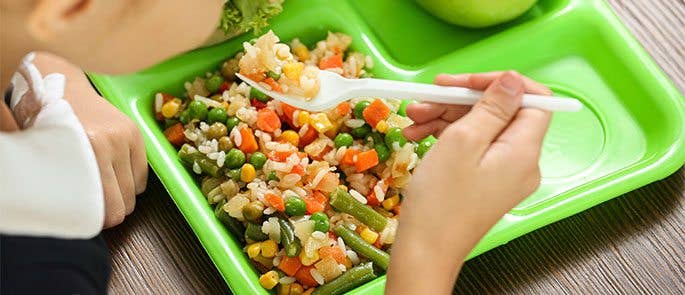
Between 2022 and 2023, 7.2 million people in the UK were living in food insecure households, an increase of 2.5 million compared to 2021. A household is deemed food insecure when members of the household reduce the quality, variety or desirability of their diets, or disrupt their eating patterns, to reduce their food intake due to a lack of money. As food insecurity continues to increase in the UK, for some children this means that school lunch is the only guaranteed meal of the day. In fact, according to the Food Foundation’s Food Insecurity Tracker, 18.7% of households with children reported that children were directly experiencing food insecurity in 2024. As such, when food is wasted in schools children miss the opportunity to eat nutritious food, which for some may be the only time that it is accessible to them.
A 2024 report by the charity School Food Matters found that whilst demand for free school meals was increasing, funding wasn’t. As a result, 38% of teachers reported that their pupils were regularly too hungry to learn. It’s estimated that due to excessively restrictive eligibility criteria over 800,000 children, despite the fact that they live in poverty, cannot access free school meals. This puts an even greater demand on schools to provide nutritious and filling food for their pupils so that they have the energy to learn and actively engage in their studies. Food waste therefore unnecessarily exacerbates the financial difficulties of schools that are already reliant on over-stretched budgets and the generosity of staff and parents to feed their pupils.
Causes of Food Waste in Schools
In their study on the causes of food waste in schools, WRAP categorised the different causes as either operational, situational or behavioural. Operational reasons include policies and practices relating to school meals and catering, such as policies on portion size flexibility or the number of pupils having school meals each day. Situational reasons relate to the broader school environment, such as the structure of the school day, rather than food specific issues. Behavioural reasons relate to individual behaviours reported to result in unserved and uneaten food.
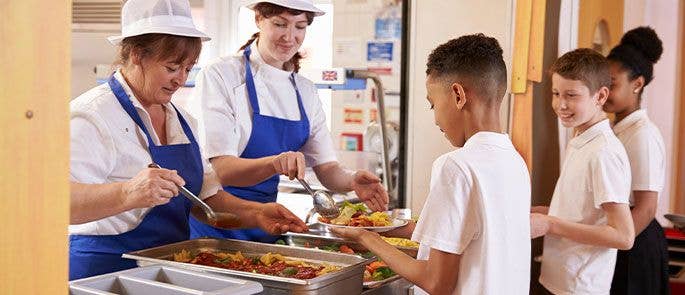
Causes of food waste in schools includes:
Operational:
- Lack of flexibility in menus planned by external catering providers.
- Kitchens over-catering to ensure pupils have the meal option of their choice.
- Prohibiting second helpings or only serving seconds if pupils pay.
- Inflexible portion sizes.
- Fixed food combinations such as rules that all meals must be accompanied by a pudding regardless of whether the student will eat it.
Situational:
- Rushed meal times to meet the demand of serving everyone.
- Practical difficulties with eating the food served, such as younger pupils not being able to properly cut their food.
- Unpleasant canteen environments resulting in pupils being eager to leave as soon as possible.
Behavioural:
- Pupils not being hungry at lunch time due to buying filling snacks at break time.
- Pupils buying snacks because they are cheaper than a full meal.
- Unpopular meal choices.
- Unfamiliar food.
- Pupils prioritising going outside to play or socialising with friends over finishing their meals.
It should be mentioned that the study notes discrepancies between expected origins of food waste within schools and observed quantitative data. Of the 16 schools surveyed, 15 highlighted the canteen as generating the majority of food waste, primarily from plate scrapings of uneaten food. Other interviewees also expressed theories that significant amounts of food waste would be found in playground bins. However, the study showed that school kitchens were a notable source of food waste.
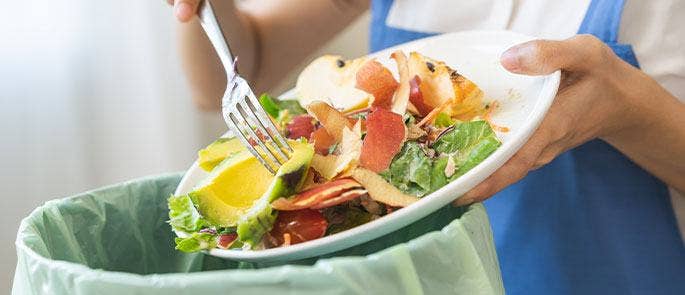
The study proposes two reasons for this discrepancy. Firstly, it suggests that those responsible for catering do not perceive that they are ‘wasting’ food and that they also don’t perceive unavoidable food waste generated during meal preparation, such as vegetable peels etc, as actually unavoidable. Secondly, it suggests that since uneaten food in the canteen is more visible to a wider range of staff and pupils, it’s easier to perceive it as the cause of the majority of food waste.
It’s important to recognise these discrepancies as efforts to reduce food waste in schools are often geared solely towards pupils. Whilst this is an effective method for reducing food waste, it puts a greater burden of responsibility on students and fails to acknowledge the necessity of adopting food waste reduction methods at the source, such as in school kitchens. Food waste reduction demands a holistic approach which engages pupils, staff and kitchen staff alike so as to be effective and consistent.
Want to Learn More?
Our Environmental Awareness Training course can help you and your staff to understand key environmental issues and provides you with the knowledge to work more sustainably. Our Food Hygiene courses also provide the necessary skills and tools to handle, prepare and serve food safely and legally.
How to Reduce Food Waste in Schools
When adopting policies to reduce food waste in schools, it is important to include pupils, teachers and kitchen staff. This will help to reduce food waste at multiple different stages of the food preparation process, rather than only focusing on the food left on plates.
Below you will find 10 ways that you can reduce food waste in your school.
- Conduct a waste audit – Conducting a waste audit will help you to determine the type and quantity of waste that is being produced and in turn, how it can be reduced. Conducting a waste audit can identify unexpected sources of food waste enabling more targeted efforts to tackle it. For example, you may assume that the majority of the food waste your school generates comes from students not finishing their meals and throwing away leftover food. However, a waste audit might reveal that the most amount of waste is generated by the kitchens. You can then use this information to focus attention where necessary to reduce food waste.
- Educate students – Educating students on the impact of food waste will provide them with the knowledge to make better informed decisions. By highlighting the impact of food waste, you can encourage students to think about their individual actions and what changes they can make to reduce food waste. This will encourage students to think twice before picking up a pudding that they may not eat, or choosing the same meal as their friends even though they know they don’t like it and are unlikely to finish it. Educating children about food waste can also easily be encompassed into school lessons such as science.
- Educate staff – As mentioned above it is important to have a holistic approach to food waste reduction that involves staff as well. WRAP’s study found that many teachers didn’t think of food waste as an issue as they had other concerns relating to students and the general day-to-day running of school. Whilst this is valid, without adult intervention and equal enthusiasm, pupils can be quick to question why they should care about food waste when the adults around them don’t. As such, staff training is important so that teachers can match student enthusiasm and bolster their understanding of the impact of food waste. This staff training could be facilitated internally or externally with courses such as our Environmental Awareness Training course. However it is done, it should be remembered that educating staff on the importance of reducing food waste is just as vital as educating children.

- Gamify it – Reducing food waste does not need to be limited to a series of restrictive commands that pupils feel obligated to follow. By making it something fun or competitive, you can actively engage students and encourage them to think creatively about how they can reduce their waste. In 2024 fourteen primary schools in Wales cut their food waste by an average of 33% after taking part in a Waste Warriors competition. As part of the competition pupils monitored and recorded the amount of food thrown away at lunchtime and then planned a campaign to reduce it. Gamifying food reduction makes it a more exciting and interesting activity which students will actively and consistently engage with.
- Start a school vegetable garden – Fruits and vegetables make up the largest proportion of food wasted in schools. A school vegetable garden not only teaches children about the science of soil and nutrition, it also shows them first hand the effort and energy that goes into growing it. This can help incentivise pupils to not waste food as they have directly seen the work that goes into producing it. The Royal Horticultural Society’s Campaign for School Gardening provides free resources so you can get started gardening at your school.
- Offer variable portion sizes – Offering smaller portions results in less waste left on plates. Many teachers want to encourage students to finish all of their food, however, if a child has been given more food than they can eat this will inevitably lead to waste. Giving the option to have smaller portions will stop students from being served more food than they can eat and it being thrown away. Conversely, some schools have a ‘no seconds’ policy resulting in edible food being thrown away rather than being served to hungry students. By removing this policy and serving students who are still hungry small secondary portions, schools can reduce the amount of leftover food that goes to waste.
- Start a school compost – A school compost ensures that wasted food is given a new lease on life and turned into something useful. Should you decide to start a school garden, the compost from your compost pile can be used to grow fruits and vegetables in said garden. As mentioned above, the government has introduced mandatory food waste separation. As such, schools will have to store, collect and dispose of food waste separately from other waste streams. This creates the perfect opportunity to divert food waste to a compost pile. The science of composting could then be incorporated into lessons and students could be encouraged to separate their waste using posters such as those attached, so as to protect the planet and provide ‘food’ for their compost pile.
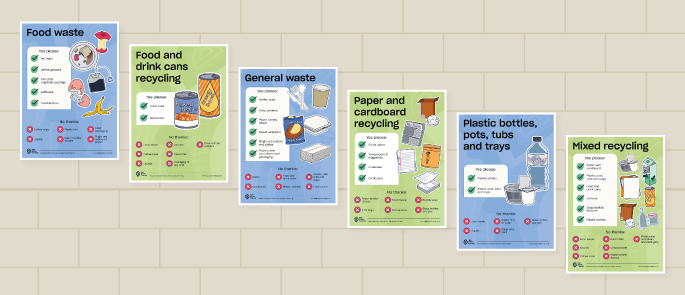
- Flexible menu planning – Providing children with nutritious meals is important, however it is also important to have a flexible approach to their likes and dislikes. For example, if you have a dish on your weekly menu that is packed full of vegetables and is incredibly nutritious, it is somewhat redundant if students don’t like it and tend to waste a lot of it each week. Instead, involve students in menu planning where possible and provide them with the option to remove something they don’t like if they won’t eat it, rather than insisting it go on their plate only to be thrown away.
- Stagger lunchtimes – An unpleasant eating environment can make students eager to leave as quickly as possible. Staggering lunchtimes helps to reduce an unmanageable rush of students thereby creating a more relaxing dining experience. This encourages pupils to take their time when eating as they will have spent less time queuing. This can also help to prevent popular choices running out too quickly and students being left with options that they didn’t want to eat and are likely to throw away.
- Use leftovers – Food waste isn’t only composed of inedible food and a lot of what is categorised as food waste is perfectly edible. Finding a way to use edible leftovers reduces food waste and creates a cyclical approach to waste in which it is reused when possible and thrown away as a last resort. As mentioned, fruits and vegetables make up the largest proportion of wasted food in schools. Edible and intact vegetables could be used in food and nutrition classes to show pupils how to make tasty meals using leftover vegetables. Similarly, leftover fruit could be used to make cakes served at break or lunchtime. Extra portions left over from lunch time could also be served to children in after-school clubs or offered to teachers who may be working late for events etc.

It is a widely held belief that children are fussy eaters and as such food waste in schools is often seen as somewhat of an inevitability. However, an article in the British Food Journal on primary school children’s response to food waste, argued that this focus ignores children’s voices and treats them as a passive audience rather than active problem solvers.
As the new regulations of the Environment Act 2021 come into effect, it is now more important than ever to involve pupils in the reduction of food waste. The new legislation not only highlights the government’s commitment to protecting the planet, it also puts greater onus on non-domestic premises, such as schools, to act more sustainably. By including students in the steps taken to reduce food waste and listening to their ideas, rather than excluding them from the conversation, teachers have the opportunity to educate the next generation and provide them with the knowledge and lifelong skills to live and act more sustainably.
Reducing food waste in schools not only helps to protect the environment, it also saves schools valuable money. By reducing the amount of food waste generated, your school can encourage pupils to consider their environmental impact and the steps that they can take individually and together to protect the planet.
Further Resources:
- 8 Teaching Methods to Use in the Classroom
- Recycling in Schools: How Can We Reduce Waste?
- CPD Courses for Teaching and Education









